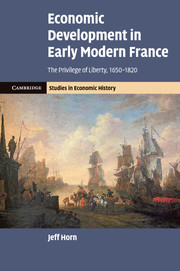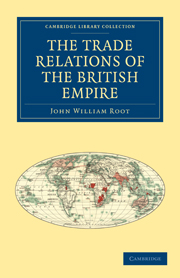Refine search
Actions for selected content:
26946 results in Economic history
8 - Trade, tariffs and growth
-
- Book:
- An Economic History of Europe
- Published online:
- 28 May 2018
- Print publication:
- 12 March 2015, pp 173-191
-
- Chapter
- Export citation
Introduction: What is economic history?
-
- Book:
- An Economic History of Europe
- Published online:
- 28 May 2018
- Print publication:
- 12 March 2015, pp 1-9
-
- Chapter
- Export citation
2 - Europe from obscurity to economic recovery
-
- Book:
- An Economic History of Europe
- Published online:
- 28 May 2018
- Print publication:
- 12 March 2015, pp 25-46
-
- Chapter
- Export citation
5 - Institutions and growth
-
- Book:
- An Economic History of Europe
- Published online:
- 28 May 2018
- Print publication:
- 12 March 2015, pp 82-106
-
- Chapter
- Export citation
10 - The era of political economy: from the minimal state to the Welfare State in the twentieth century
-
- Book:
- An Economic History of Europe
- Published online:
- 28 May 2018
- Print publication:
- 12 March 2015, pp 213-237
-
- Chapter
- Export citation
SKILL SELECTIVITY IN TRANSATLANTIC MIGRATION: THE CASE OF CANARY ISLANDERS IN CUBA*
-
- Journal:
- Revista de Historia Economica - Journal of Iberian and Latin American Economic History / Volume 33 / Issue 2 / September 2015
- Published online by Cambridge University Press:
- 12 March 2015, pp. 189-222
- Print publication:
- September 2015
-
- Article
- Export citation
11 - Inequality among and within nations: past, present, future
-
- Book:
- An Economic History of Europe
- Published online:
- 28 May 2018
- Print publication:
- 12 March 2015, pp 238-255
-
- Chapter
- Export citation
List of figures
-
- Book:
- An Economic History of Europe
- Published online:
- 28 May 2018
- Print publication:
- 12 March 2015, pp x-xi
-
- Chapter
- Export citation
3 - Population, economic growth and resource constraints
-
- Book:
- An Economic History of Europe
- Published online:
- 28 May 2018
- Print publication:
- 12 March 2015, pp 47-66
-
- Chapter
- Export citation

Economic Development in Early Modern France
- The Privilege of Liberty, 1650–1820
-
- Published online:
- 05 March 2015
- Print publication:
- 26 February 2015

Energy and the English Industrial Revolution
-
- Published online:
- 05 March 2015
- Print publication:
- 19 August 2010

The Trade Relations of the British Empire
-
- Published online:
- 05 March 2015
- Print publication:
- 16 December 2010
- First published in:
- 1903
RHE volume 33 issue 1 Cover and Back matter
-
- Journal:
- Revista de Historia Economica - Journal of Iberian and Latin American Economic History / Volume 33 / Issue 1 / March 2015
- Published online by Cambridge University Press:
- 18 March 2015, pp. b1-b8
- Print publication:
- March 2015
-
- Article
-
- You have access
- Export citation
RHE volume 33 issue 1 Cover and Front matter
-
- Journal:
- Revista de Historia Economica - Journal of Iberian and Latin American Economic History / Volume 33 / Issue 1 / March 2015
- Published online by Cambridge University Press:
- 18 March 2015, pp. f1-f3
- Print publication:
- March 2015
-
- Article
-
- You have access
- Export citation
UNA DE CAL Y OTRA DE ARENA: BUILDING COMPARABLE REAL WAGES IN A GLOBAL PERSPECTIVE
-
- Journal:
- Revista de Historia Economica - Journal of Iberian and Latin American Economic History / Volume 33 / Issue 1 / March 2015
- Published online by Cambridge University Press:
- 18 March 2015, pp. 61-75
- Print publication:
- March 2015
-
- Article
- Export citation
PRECIOS, PRODUCTO AGRARIO Y NIVELES DE VIDA EN LAS FRONTERAS RIOPLATENSES, 1700-1810: UNA NUEVA MIRADA SOBRE EL CRECIMIENTO ECONÓMICO TARDOCOLONIAL*: Prices, Agrarian Output and Living Standards in the River Plate Borders, 1700-1810: A New Look into Economic Growth in the Late Colonial Era
-
- Journal:
- Revista de Historia Economica - Journal of Iberian and Latin American Economic History / Volume 33 / Issue 1 / March 2015
- Published online by Cambridge University Press:
- 18 March 2015, pp. 123-152
- Print publication:
- March 2015
-
- Article
- Export citation
EDITORS’ NOTE
-
- Journal:
- Revista de Historia Economica - Journal of Iberian and Latin American Economic History / Volume 33 / Issue 1 / March 2015
- Published online by Cambridge University Press:
- 18 March 2015, pp. 3-13
- Print publication:
- March 2015
-
- Article
-
- You have access
- HTML
- Export citation
OPTIMISTIC BUT FLAWED? A REPLY
-
- Journal:
- Revista de Historia Economica - Journal of Iberian and Latin American Economic History / Volume 33 / Issue 1 / March 2015
- Published online by Cambridge University Press:
- 18 March 2015, pp. 77-82
- Print publication:
- March 2015
-
- Article
- Export citation
MEXICO’S REAL WAGES IN THE AGE OF THE GREAT DIVERGENCE, 1730-1930*
-
- Journal:
- Revista de Historia Economica - Journal of Iberian and Latin American Economic History / Volume 33 / Issue 1 / March 2015
- Published online by Cambridge University Press:
- 18 March 2015, pp. 83-122
- Print publication:
- March 2015
-
- Article
- Export citation
SALARIOS Y PRECIOS DE LOS FACTORES EN BUENOS AIRES, 1770-1880: UNA APROXIMACIÓN A LA DISTRIBUCIÓN FUNCIONAL DEL INGRESO EN EL LARGO PLAZO*: Wages and Prices of Factors of Production in Buenos Aires, 1770-1880. An Approach to Functional Income Distribution in the Long Run
-
- Journal:
- Revista de Historia Economica - Journal of Iberian and Latin American Economic History / Volume 33 / Issue 1 / March 2015
- Published online by Cambridge University Press:
- 18 March 2015, pp. 153-186
- Print publication:
- March 2015
-
- Article
- Export citation
